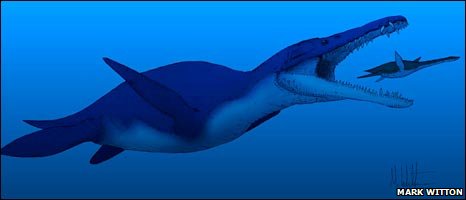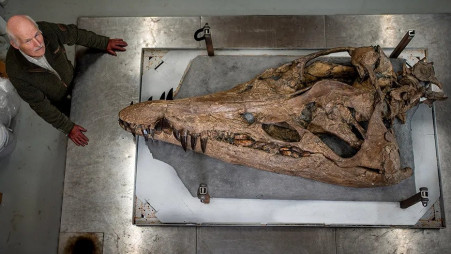The cliffs of Dorset’s Jurassic Coast have yielded the skull of an enormous sea monster, a Pliosaur, known for its menacing presence in the seas around 150 million years ago.
This 2-meter-long fossil, representing one of the most intact specimens of its kind ever found, is providing valuable insights into the nature of this ancient marine predator. The unveiling of the skull, featured in a special David Attenborough program on BBC One on New Year’s Day, evokes astonishment as it becomes clear that this particular Pliosaur is not only massive but also remarkably well-preserved. Local paleontologist Steve Etches expresses his belief that there is no other specimen elsewhere that rivals the size and quality of this extraordinary find.

“It stands out as one of the most exceptional fossils I’ve had the opportunity to study,” he informs BBC News. “What distinguishes it is its completeness. The lower jaw and upper skull are fused, mimicking their natural alignment in life. Globally, specimens with such meticulous detail are exceedingly rare. Even when found, many lack various components, unlike this specimen which, although slightly distorted, boasts the presence of every bone. The skull surpasses the length of the average human, providing a glimpse into the overall size of the creature. The 130 teeth, particularly those at the front, inevitably capture one’s attention.”

Sharp and elongated, capable of causing fatal harm in a single bite, the teeth of this creature reveal a more intricate design upon closer inspection – a network of fine ridges adorning the back of each tooth. These ridges served a crucial purpose, aiding the beast in penetrating flesh and swiftly withdrawing its dagger-like fangs, poised for a rapid follow-up assault.
The pliosaur, measuring 10-12 meters in length and equipped with four formidable flipper-like limbs for swift propulsion, stood as the unrivaled apex predator of the ocean. Dr. Andre Rowe of Bristol University notes, “The sheer enormity of the animal suggests it could effectively prey on anything unfortunate enough to share its territory.”
- Misleading Video Alters Prime Minister Shehbaz’s Speech Targeting Political Rival, Not His Party - 21/04/2024
- ATC Grants Three-Day Remand for Suspects in Ichhra Bazaar Harassment Case - 19/03/2024
- Pakistan, India, and Bangladesh Lead World in Severe Smog Crisis, Exceeding WHO Guidelines - 19/03/2024


